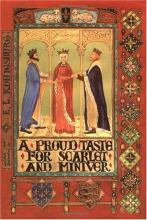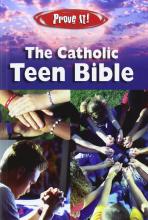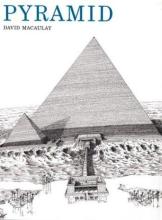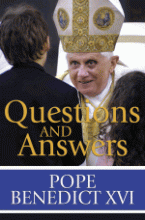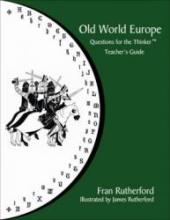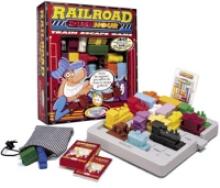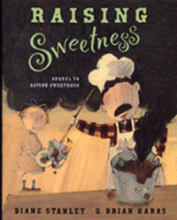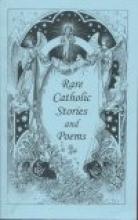No name
Proud Taste For Scarlet and Miniver
This story is written fairly informally from the surprising vantage point of a cloud in heaven, where Eleanor of Aquitaine (12th century duchess from Acquitaine, in France) and three friends take turns recounting various events from her life. The novel is filled with historical details, particularly the lifestyle and family tree of the Plantagenet and the Capet families (King Henry II of England, Saint Thomas Becket, King Louis VII of France, King Richard the Lion Heart), and it is all presented in an entertaining manner. It is probably available at your local library. It would be a terrific read-aloud if your family is studying the Middle Ages. Children over 10 years of age would enjoy reading this book on their own.
Prove It! The Catholic Teen Bible
New American Bible Translation (copyright 1970-1991)
Also contains seven full-color multipage inserts.
This Bible offers a creative and colorful format to help encourage teens to read the real text of the Bible. It is a real, complete Bible with inserts tucked in between the text. The full-color, glossy inserts run from eight to sixteen pages in length (a total of sixty pages). These inserts highlight and discuss important topics of the faith while continually encouraging the reader to do further study within the Bible itself (with lots of specific Bible references to help facilitate that). The text of these inserts is meaty, but easy to understand. The layout is attractive and contemporary, combining images of Christ and the Saints with photos of modern teens. You can see that the author has aimed at appealing to the best in teens by helping them make sense out of the Catholic faith.
The introductory insert offers some tips for getting started and a table of contents for the insert sections.
The first insert, "God; How do I know God exists?", explores the topic of basic Christian belief through scripture, tradition and reason (logic). This segment also explores the topics of: "Who is God?", "What is the Trinity?", "One God?", Consequences of the existence of God, "Why do people suffer?", and "Made in God's image."
The second insert, "Jesus" covers questions and the basic facts about the Life of Christ. This segment grapples with the following topics: "Who is Jesus?", "Can I trust the gospels?", "What did Jesus do?", "What's a miracle?", "Mary, Mother of God", "Jesus died for my sins. What does that mean?", "Jesus was a great teacher. Can't I just believe that?", "The Resurrection", "If Jesus is Lord, then...", and "When will Jesus come again - and how?"
The third insert is on the Church. This covers "What is the Church?", What does Jesus have to do with the Church?", "How can the Church be holy when it has sinners in it?", "What is the Church for?", "The Sacraments: Meeting Jesus", "Can People who aren't Catholic be saved?", "If Jesus is present in the Church, then..." the basics of what it means to be a Caholic (attending Mass, receiving the Sacrament of Reconciliation, etc.)
The fourth insert covers the topic of prayer, including "What is prayer?", "Great Moments in Prayer", "Different forms of prayer", "Learning to Pray", "Doesn't God already know how I feel?", "What should I feel when I pray?", "Why pray to saints?", "Does God answer prayers?", "I should trust prayers that have helped others draw closer to God."
The fifth section is entitled "You". This segment very cleverly handles topics involving: the Sancity of Life, Vocations, the Sanctity of Marriage, the Commandments and Beatitudes, Spiritual and Corporal Works of Mercy, and more.
The final section, "The Map" outlines the guidelines the Church gives us to follow Christ and keep his laws. It covers the Commandments, the Virtues, Gifts of the Holy Spirit, Fruits of the Holy Spirit, "Wrong Turns", the Four Last Things and prayers, including the Stations of the Cross and directions for saying the Rosary.
This book offers a very creative concept for encouraging teens who wouldn't ordinarily be drawn toward reading the Bible into picking it up and at the same time delving deeper into their Catholic faith. The one real downside is the translation. Although the New American Bible translation is commonly used at Mass throughout the United States (and it is not overtly evil!), it is reputed to have subtle inaccuracies that can distort or confuse the meaning of certain passages. However, as Catholic Answers succinctly put it, "So, which Bible is the best? Perhaps the best answer is this: The one you'll read." Keeping that in mind, I think this Bible would make an excellent Confirmation present for teenagers in your life - particularly those who have very little experience with the Bible and/or their faith in general. Homeschool students may also enjoy using this book to explore the Bible on their own. My own 11 year old daughter is eager to get her hands on my copy as soon as this review is complete. :) It would be best if this isn't the only translation studied, but it doesn't seem like a bad place to start.
The updated 2011 edition, ISBN 9781592761951, uses the NABRE version. We have concerns about this translation: please see our separate review of the revised NAB version here.
Pyramid
Black and white illustrations and readable text take you through the building of a fictional pyramid in Ancient Egypt (but so close to reality that you'll hardly know the difference) from the beginning plans of a Pharaoh for his final resting place, thorugh years of construction, and finally, the Pharaoh's death, mummification and entombment. Fortunately, the emphasis is on the design and construction of the pyramid rather than mummification. The many detailed pictures illustrate tools, techniques, materials used, etc. This is a very nice book and comes highly recommended. It is geared toward the 10-14 year old range, but my younger children have enjoyed it as a read aloud (my son in particular pores over the pictures and wants to know what each of the construction tools is for – such a boy!). The information is interesting and detailed enough to be read by teens or adults as well.
Questions and Answers
A topical index is included.
Questions for the Thinker, Old World Europe
Railroad RushHour: Train Escape Game
I can hardly say enough good things about this fun and thought-provoking game (which a good friend gave to my son for his birthday a few days ago). Each of the 50 playing cards presents a puzzle scenario which you set up on the gameboard with the train pieces. The object is to move the pieces around until you can get the red locomotive off the board. The puzzle scenarios gradually increase in difficulty, but all of them are fun and challenging (even for parents!). Our family has already enjoyed many hours with this puzzle and, given the large number of puzzle scenarios, the variety of challenge levels and the keen interest to a broad range of ages, I'm sure we'll be enjoying and learning from it for a long time to come. Our children as young as six were able to play the game.
Although there are a number of pieces, they are big enough to not get lost too easily or be terribly dangerous for little ones (although I wouldn't trust those in the choking-range with the pieces). We punched holes in the card deck and keep them together with a binder ring. My only complaint is that the colors of the playing pieces didn't match the colors on the playing cards very well.
Includes: game board with 19 pieces, card deck and travel bag
Raising Sweetness
Rand McNally Historical Atlas of the World
This is a full-color, reasonably priced booklet of historical maps from every major age and civilization. It would be a worthwhile to every library – public or private. Here is a complete list of the larger two-page maps contained in this book (there are numerous smaller maps as well):
- Human Emergence on the Changing Face of the Earth: Growth of Civilization to 200 A.D.
- Alexander's Empire 336-323 B.C.
- Roman Republic 31 B.C.
- Roman Empire about 120 A.D.
- Roman Empire about 400 A.D.
- Easter and Southern Asia About 750 A.D.
- Islamic World c. 800 A.D.
- International Trade 1350 A.D. – 1450 A.D.
- Europe and the Crusader States about 1140
- Asia at the death of Kublai Khan (1294)
- Europe (about 1360)
- European Civilization during the Renaissance
- Europe's Age of Discovery 15th-17th Centuries
- The Ottoman, Safavid and Mughal Emipres in the 16th and 17th centuries
- East Asia 16th Century
- Eastern and Southern Asia about 1775
- The Holy Roman Empire after the Peace of Westphalia 1648
- Europe in 1721
- Native America
- Revolutions in the Atlantic World 1776-1826
- Westward Expansion 1800-1850
- Latin America about 1790
- Latin American 1800-1900
- Latin America after Independence: 1821-1929
- Expansion of Russia in Europe
- Languages of Europe in the 19th Century
- European Partition of Africa: 19th Century
- Resistance to European Colonialism: 1870-1917
- The World about 1900
- Asia 1900
- Europe 1922-1940
- World War II
- Easter Mediterranean Area: 1945-1990
- and Current World and Political and Physical Maps
Rare Catholic Stories and Poems
Make sure you have a hankie close by when you read these books. These faith inspiring stories surely must have contributed to the steadfastness that Catholic children displayed years ago. The stories in both volumes include main characters that are young and old, male and female thus appealing to everyone. Each story is short enough to be read by an average 4th grader in five to ten minutes. Follow up comprehension questions range from simple recall to more the more thought provoking type that would open the door to many wonderful parent child discussions. We had our children read this book straight through as their spiritual reading and at a later time had them read some of the stories again and work through the comprehension questions. This book would also serve well as a source for bedtime stories or for poetry memorization. Volume 1, which is suitable for grade 3 and up, is a small softcover book 5½" x 8½" and includes several illustrations for each story.

